Hashmat Shadab Malik
Hierarchical Self-Supervised Adversarial Training for Robust Vision Models in Histopathology
Mar 13, 2025Abstract:Adversarial attacks pose significant challenges for vision models in critical fields like healthcare, where reliability is essential. Although adversarial training has been well studied in natural images, its application to biomedical and microscopy data remains limited. Existing self-supervised adversarial training methods overlook the hierarchical structure of histopathology images, where patient-slide-patch relationships provide valuable discriminative signals. To address this, we propose Hierarchical Self-Supervised Adversarial Training (HSAT), which exploits these properties to craft adversarial examples using multi-level contrastive learning and integrate it into adversarial training for enhanced robustness. We evaluate HSAT on multiclass histopathology dataset OpenSRH and the results show that HSAT outperforms existing methods from both biomedical and natural image domains. HSAT enhances robustness, achieving an average gain of 54.31% in the white-box setting and reducing performance drops to 3-4% in the black-box setting, compared to 25-30% for the baseline. These results set a new benchmark for adversarial training in this domain, paving the way for more robust models. Our Code for training and evaluation is available at https://github.com/HashmatShadab/HSAT.
Robust-LLaVA: On the Effectiveness of Large-Scale Robust Image Encoders for Multi-modal Large Language Models
Feb 03, 2025



Abstract:Multi-modal Large Language Models (MLLMs) excel in vision-language tasks but remain vulnerable to visual adversarial perturbations that can induce hallucinations, manipulate responses, or bypass safety mechanisms. Existing methods seek to mitigate these risks by applying constrained adversarial fine-tuning to CLIP vision encoders on ImageNet-scale data, ensuring their generalization ability is preserved. However, this limited adversarial training restricts robustness and broader generalization. In this work, we explore an alternative approach of leveraging existing vision classification models that have been adversarially pre-trained on large-scale data. Our analysis reveals two principal contributions: (1) the extensive scale and diversity of adversarial pre-training enables these models to demonstrate superior robustness against diverse adversarial threats, ranging from imperceptible perturbations to advanced jailbreaking attempts, without requiring additional adversarial training, and (2) end-to-end MLLM integration with these robust models facilitates enhanced adaptation of language components to robust visual features, outperforming existing plug-and-play methodologies on complex reasoning tasks. Through systematic evaluation across visual question-answering, image captioning, and jail-break attacks, we demonstrate that MLLMs trained with these robust models achieve superior adversarial robustness while maintaining favorable clean performance. Our framework achieves 2x and 1.5x average robustness gains in captioning and VQA tasks, respectively, and delivers over 10% improvement against jailbreak attacks. Code and pretrained models will be available at https://github.com/HashmatShadab/Robust-LLaVA.
Towards Evaluating the Robustness of Visual State Space Models
Jun 13, 2024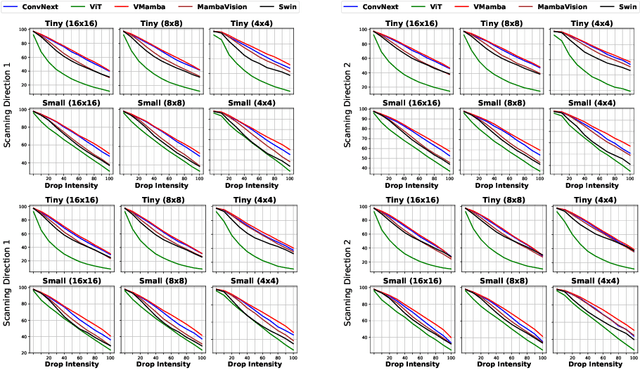
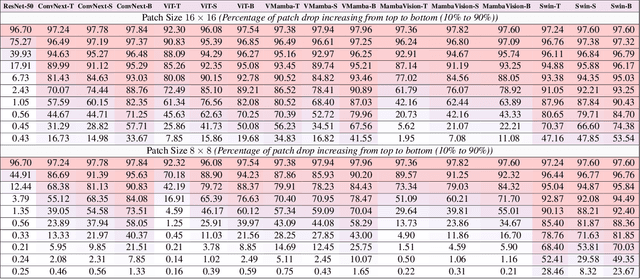
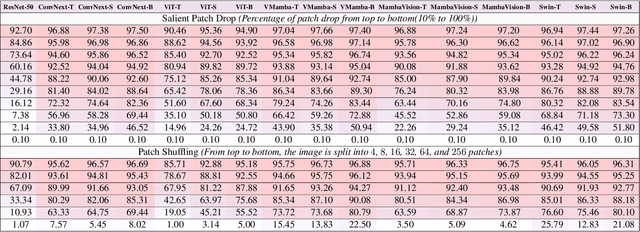

Abstract:Vision State Space Models (VSSMs), a novel architecture that combines the strengths of recurrent neural networks and latent variable models, have demonstrated remarkable performance in visual perception tasks by efficiently capturing long-range dependencies and modeling complex visual dynamics. However, their robustness under natural and adversarial perturbations remains a critical concern. In this work, we present a comprehensive evaluation of VSSMs' robustness under various perturbation scenarios, including occlusions, image structure, common corruptions, and adversarial attacks, and compare their performance to well-established architectures such as transformers and Convolutional Neural Networks. Furthermore, we investigate the resilience of VSSMs to object-background compositional changes on sophisticated benchmarks designed to test model performance in complex visual scenes. We also assess their robustness on object detection and segmentation tasks using corrupted datasets that mimic real-world scenarios. To gain a deeper understanding of VSSMs' adversarial robustness, we conduct a frequency analysis of adversarial attacks, evaluating their performance against low-frequency and high-frequency perturbations. Our findings highlight the strengths and limitations of VSSMs in handling complex visual corruptions, offering valuable insights for future research and improvements in this promising field. Our code and models will be available at https://github.com/HashmatShadab/MambaRobustness.
On Evaluating Adversarial Robustness of Volumetric Medical Segmentation Models
Jun 12, 2024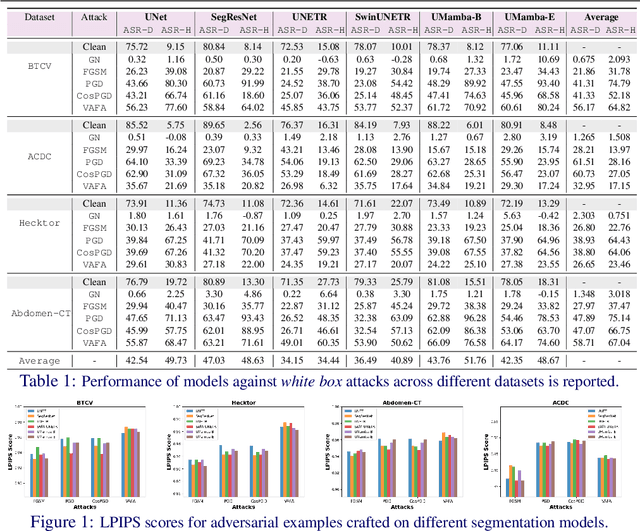

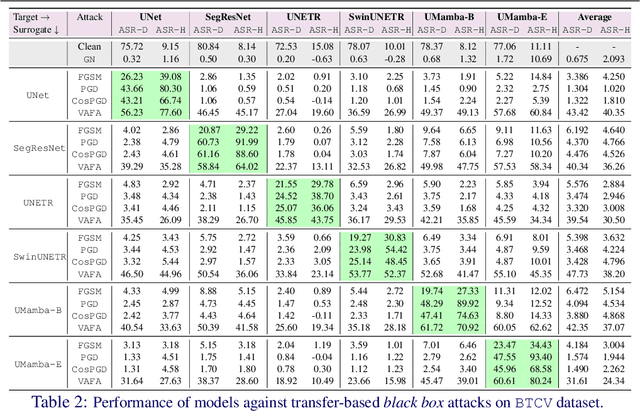
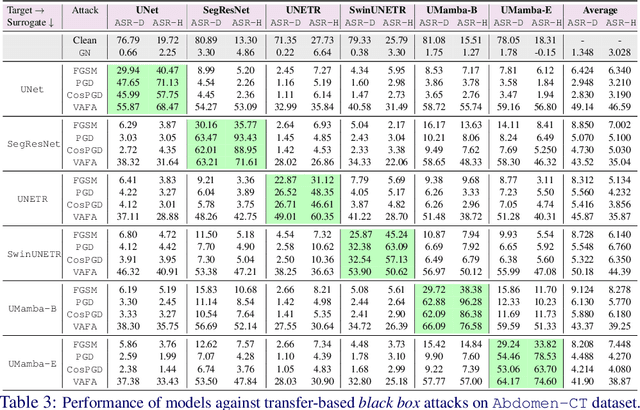
Abstract:Volumetric medical segmentation models have achieved significant success on organ and tumor-based segmentation tasks in recent years. However, their vulnerability to adversarial attacks remains largely unexplored, raising serious concerns regarding the real-world deployment of tools employing such models in the healthcare sector. This underscores the importance of investigating the robustness of existing models. In this context, our work aims to empirically examine the adversarial robustness across current volumetric segmentation architectures, encompassing Convolutional, Transformer, and Mamba-based models. We extend this investigation across four volumetric segmentation datasets, evaluating robustness under both white box and black box adversarial attacks. Overall, we observe that while both pixel and frequency-based attacks perform reasonably well under white box setting, the latter performs significantly better under transfer-based black box attacks. Across our experiments, we observe transformer-based models show higher robustness than convolution-based models with Mamba-based models being the most vulnerable. Additionally, we show that large-scale training of volumetric segmentation models improves the model's robustness against adversarial attacks. The code and pretrained models will be made available at https://github.com/HashmatShadab/Robustness-of-Volumetric-Medical-Segmentation-Models.
ObjectCompose: Evaluating Resilience of Vision-Based Models on Object-to-Background Compositional Changes
Mar 15, 2024Abstract:Given the large-scale multi-modal training of recent vision-based models and their generalization capabilities, understanding the extent of their robustness is critical for their real-world deployment. In this work, we evaluate the resilience of current vision-based models against diverse object-to-background context variations. The majority of robustness evaluation methods have introduced synthetic datasets to induce changes to object characteristics (viewpoints, scale, color) or utilized image transformation techniques (adversarial changes, common corruptions) on real images to simulate shifts in distributions. Recent works have explored leveraging large language models and diffusion models to generate changes in the background. However, these methods either lack in offering control over the changes to be made or distort the object semantics, making them unsuitable for the task. Our method, on the other hand, can induce diverse object-to-background changes while preserving the original semantics and appearance of the object. To achieve this goal, we harness the generative capabilities of text-to-image, image-to-text, and image-to-segment models to automatically generate a broad spectrum of object-to-background changes. We induce both natural and adversarial background changes by either modifying the textual prompts or optimizing the latents and textual embedding of text-to-image models. This allows us to quantify the role of background context in understanding the robustness and generalization of deep neural networks. We produce various versions of standard vision datasets (ImageNet, COCO), incorporating either diverse and realistic backgrounds into the images or introducing color, texture, and adversarial changes in the background. We conduct extensive experiment to analyze the robustness of vision-based models against object-to-background context variations across diverse tasks.
Adversarial Pixel Restoration as a Pretext Task for Transferable Perturbations
Jul 18, 2022



Abstract:Transferable adversarial attacks optimize adversaries from a pretrained surrogate model and known label space to fool the unknown black-box models. Therefore, these attacks are restricted by the availability of an effective surrogate model. In this work, we relax this assumption and propose Adversarial Pixel Restoration as a self-supervised alternative to train an effective surrogate model from scratch under the condition of no labels and few data samples. Our training approach is based on a min-max objective which reduces overfitting via an adversarial objective and thus optimizes for a more generalizable surrogate model. Our proposed attack is complimentary to our adversarial pixel restoration and is independent of any task specific objective as it can be launched in a self-supervised manner. We successfully demonstrate the adversarial transferability of our approach to Vision Transformers as well as Convolutional Neural Networks for the tasks of classification, object detection, and video segmentation. Our codes & pre-trained surrogate models are available at: https://github.com/HashmatShadab/APR
Object Detection in Aerial Images: What Improves the Accuracy?
Jan 21, 2022



Abstract:Object detection is a challenging and popular computer vision problem. The problem is even more challenging in aerial images due to significant variation in scale and viewpoint in a diverse set of object categories. Recently, deep learning-based object detection approaches have been actively explored for the problem of object detection in aerial images. In this work, we investigate the impact of Faster R-CNN for aerial object detection and explore numerous strategies to improve its performance for aerial images. We conduct extensive experiments on the challenging iSAID dataset. The resulting adapted Faster R-CNN obtains a significant mAP gain of 4.96% over its vanilla baseline counterpart on the iSAID validation set, demonstrating the impact of different strategies investigated in this work.
 Add to Chrome
Add to Chrome Add to Firefox
Add to Firefox Add to Edge
Add to Edge